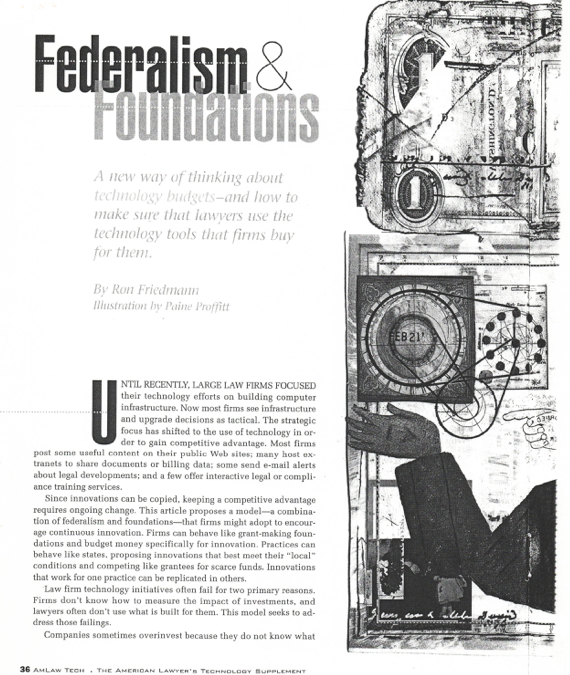Absent from many articles and much discussion is the long view of legal innovation. If you have read the legal trade press or attended conferences this year, you could easily believe legal innovation started in 2018, maybe 2017. In dispelling that, I pose a question, not offer an answer.
Two weeks ago I posted Legal Innovation – Revolution or Evolution?, I concluded “evolution”. That made me think about two questions. First, I wondered, just how many firms or law departments have formal efforts? Though I maintain a list of firm with R&D or innovation initiatives, I doubt it includes all. So the number remains a mystery. And second, I wondered, for firms that have “declared innovation”, what’s the staffing and funding and how centralized vs decentralized is it?
I don’t have answers but in searching for some, I remembered an article I wrote 15 years ago. AmLaw Tech (now defunct) published in March 2003 my article Federalism & Foundations. I proposed a model for innovation, a combination of federalism and foundations. Firms can behave like grant-making foundations and budget money specifically for innovation. Practices can behave like states, proposing innovations that best meet their “local” conditions and competing like grantees for scarce funds. Innovations that work for one practice can be replicated in others. And the central innovation can promote successes across states (er, I mean practices).
Fifteen years later, does that model have merit? Does it work? And how exactly do we answer these questions?
We know that change management remains a hard problem to solve: many lawyers resist new ways of working. Plus, just how much has changed since I wrote that article. To be sure, we have lots of new tech. I reject the premise that new tech equals change. I’m not alone. For example, in Becoming a Trusted Adviser in the Age of Disruption (The American Lawyer, 28 September 2018), authors Joseph Altonji and Kate Sweetman ask “what has fundamentally changed in the legal profession in the last 20 years?”. They say not much, despite new tech.
Despite law firms regularly announcing innovations initiatives, have we figured out how to really move the needle on client value? Do we know what works and what does not? Given the challenges and slow pace of change, I suspect not.
So maybe we still do need a theory of legal innovation. Does the central funding I proposed (“foundations”) with demand driven by practice groups (“federalism”) make sense? Is it helpful? Are firms doing it? What are better models?
In my last post, I offered a different model:
- Voice of the client.
- Management support.
- Resources to try out ideas.
I view this model as enhancing federalism and foundations. It adds a layer positing that change, whether coming from practices or centrally, must stem from listening to clients.
The floor is open for discussion.
Endnote: I draft a post and then put it down and come back to edit it. During that time, I read about another model of innovating: Microsoft’s Strategic Partner Program (SPP). Microsoft convened a group of outside counsel last week to discuss innovation. Bill Henderson, an invited, provides a fabulous write up today in Can Microsoft hit “refresh” on client-law firm relations?
Archives
Blog Categories
- Alternative Legal Provider (44)
- Artificial Intelligence (AI) (57)
- Bar Regulation (13)
- Best Practices (39)
- Big Data and Data Science (14)
- Blockchain (10)
- Bloomberg Biz of Law Summit – Live (6)
- Business Intelligence (21)
- Contract Management (21)
- Cool Legal Conferences (13)
- COVID-19 (11)
- Design (5)
- Do Less Law (40)
- eDiscovery and Litigation Support (165)
- Experience Management (12)
- Extranets (11)
- General (194)
- Innovation and Change Management (188)
- Interesting Technology (105)
- Knowledge Management (229)
- Law Department Management (20)
- Law Departments / Client Service (120)
- Law Factory v. Bet the Farm (30)
- Law Firm Service Delivery (128)
- Law Firm Staffing (27)
- Law Libraries (6)
- Legal market survey featured (6)
- Legal Process Improvement (27)
- Legal Project Management (26)
- Legal Secretaries – Their Future (17)
- Legal Tech Start-Ups (18)
- Litigation Finance (5)
- Low Cost Law Firm Centers (22)
- Management and Technology (179)
- Notices re this Blog (10)
- Online Legal Services (64)
- Outsourcing (141)
- Personal Productivity (40)
- Roundup (58)
- Structure of Legal Business (2)
- Supplier News (13)
- Visual Intelligence (14)

